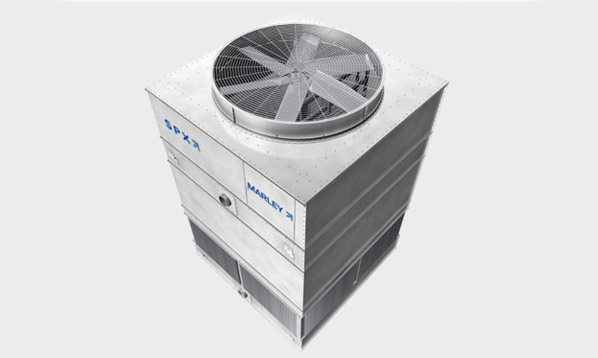什么是冷却塔?
冷却塔是 专用热交换器 空气和水直接接触,以便 降低水温当这种情况发生时,少量的水就会蒸发,从而降低流经塔的水的温度。
经过工业过程或空调冷凝器加热的水,通过管道被泵送到冷却塔。水通过喷嘴喷洒到被称为“充满” 可以减缓水流过冷却塔的速度,并尽可能多地暴露水面,以实现最大程度的空气与水的接触。当水流过冷却塔时,它会暴露在空气中,而空气是由电动机驱动的风扇拉动穿过冷却塔的。
当水和空气相遇时,少量的水 蒸发,产生冷却作用。冷却后的水随后被泵回冷凝器或工艺设备,在那里 吸收热量然后将其泵回冷却塔再次冷却。 冷却塔基础知识 提供了一定程度的基本冷却塔知识,对于想要了解更多信息的人来说是一个很好的资源。
冷却塔的类型
横流冷却塔
逆流冷却塔
逆流冷却塔 其设计使得空气垂直向上流动,与填充物中落水的流动方向相反。
由于这种垂直气流,无法使用横流式冷却塔中常见的开放式重力流水盆。相反,逆流式冷却塔采用加压管道式喷水系统将水喷洒到填料顶部。
由于空气必须能够通过喷雾系统,因此管道和喷嘴之间的距离必须更远,以免限制气流。
诱导通风冷却塔与强制通风冷却塔
工厂组装(FAP)与现场安装(FEP)冷却塔
工厂组装的塔 (FAP)的建造和运输尽可能分几个部分进行,以适应运输方式。相对较小的冷却塔基本上可以完整运输。较大的多单元冷却塔在工厂以模块形式制造,运输时即可进行最终组装。工厂组装的冷却塔也被称为“包装“ 或者 ”联邦援助计划”(工厂组装产品)。工厂组装的冷却塔可以是横流式或逆流式,也可以是诱导通风式或强制通风式,具体取决于具体应用。虽然所有应用各不相同,但工厂组装的 Marley NC 横流诱导通风塔广泛应用于暖通空调 (HVAC) 和轻工业领域。
现场安装的冷却塔 (聚全氟乙丙烯) 现场安装冷却塔主要在最终使用现场建造。所有大型冷却塔以及许多小型冷却塔均采用预制、逐件标记并运输至现场进行最终组装。制造商通常提供最终组装的人工和监督。现场安装冷却塔可以是横流式或逆流式,具体取决于应用场合。对于电力和重工业应用,现场安装冷却塔 Marley F400 逆流塔 可以定制以满足您对性能、结构、漂移和羽流减少的精确规格。
采用整体系统方法,每个冷却塔和组件都经过精心设计和制造,作为一个集成系统协同工作,以实现高效的性能和较长的使用寿命。
HVAC 自然冷却 – 自然冷却系统允许冷却塔直接满足建筑物的制冷需求,而无需在寒冷天气下运行冷却器。自然冷却系统的目标是节能。自然冷却系统有特定类型,并且必须具备某些要素才能考虑采用自然冷却系统。 单击此处了解有关 SPX 免费冷却的更多信息。
可变流量 – 如果冷却塔可以在非高峰条件下以可变流量运行,则可能会节省大量能源。可变流量是一种最大限度提高安装塔容量效率的方法,无论工艺流程的流量是多少。 了解有关 SPX 可变流量的更多信息.
OEM零件 – 精心设计,提供可靠的产品, 马利 OEM 零件 按照最高标准和最严格的公差制造,以延长使用寿命。
减速机® 解决方案 – 齿轮箱有多种设计和减速比,以适应冷却塔不同的风扇转速和马力。 马利减速器解决方案 该计划让客户可以从 SPX 订购用于塔的新替换变速箱,或者让经过工厂培训的技术人员修理现有的变速箱或使用 Marley OEM 零件重建变速箱。
充满 - 冷却塔最重要的部件之一是填料。填料能否最大程度地增加空气与水之间的接触面积和接触时间,决定了冷却塔的效率。填料有两种基本类型: 飞溅式填充 (打破水)和 薄膜型填充 (将水铺成薄层)。
除水器 – 旨在去除排放空气中的水滴并减少工艺用水的损失, 除水器 导致空气和水滴的方向突然改变。这会导致水滴与空气分离并重新沉积到塔内。
喷嘴 – 横流配置允许使用重力流分配系统与喷嘴,如 马利街该系统将供水提升至高于填料的热水分配盆,然后通过位于分配盆底部的喷嘴(重力作用)流过填料。逆流配置需要使用压力式封闭管道和喷嘴系统,例如 马利 NS.
粉丝们 – 冷却塔风机必须高效地输送大量空气,并将振动降至最低。制造材料不仅必须与其设计兼容,还必须能够承受风机运行环境的腐蚀作用。 Marley 超静音风扇 是一个可以在需要极低噪音的情况下使用的风扇的示例。
传动轴 – 驱动轴将动力从电机的输出轴传输到减速机的输入轴。由于驱动轴在冷却塔内运行,因此必须具有高度的耐腐蚀性。在电机全速运转时,驱动轴必须保持良好的平衡,并且能够重新平衡。由于冷却塔的规格要求严格, Marley Comp-DS 碳纤维传动轴 被设计出来。
有关 SPX Cooling Tech 如何满足您的冷却塔需求的具体信息,请联系您当地的 马利销售代表.




